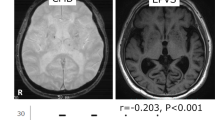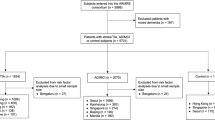Abstract
Background
Hyperhomocysteinemia is associated with cerebral small vessel disease (SVD). We examined the relationship between homocysteine and 1) volumetric measure of white matter change (WMC), 2) silent brain infarcts, 3) cerebral atrophy on MRI and 4) cognition on a consecutive cohort of patients with stroke associated with SVD.
Subjects and methods
Fifty–seven patients consecutively admitted to the Acute Stroke Unit in a university hospital due to stroke associated with SVD were recruited and assessed three months after the stroke. Non–fasting homocysteine was obtained. Using MRI, the number of infarcts, volume of WMC and cerebral atrophy were measured. General cognitive functions were assessed using the Mini Mental State Examination and Alzheimer's disease Assessment Scale. Mattis Dementia Rating Scale – Initiation/Perseveration subset was used to assess executive cognitive functions.
Results
Hyperhomocysteinemia (≥ 14.88 μmol/L) significantly accounted for the volume of WMC on MRI in a multivariate stepwise regression model (adjusted R2=0.058, p <0.05) after adjustment for age and folate level. Patients in the highest quartile of WMC volume had significantly higher levels of homocysteine than those in lowest quartile (p <0.001). No significant relationship was found between homocysteine and silent brain infarcts, cerebral atrophy and performance on psychometric tests.
Conclusion
Hyperhomocysteinemia is associated with volumetric measure of WMC among patients with SVD. The role of homocysteine in the development of silent brain infarcts and cerebral atrophy as previously reported cannot be ascertained in this study. No direct relationship was found between homocysteine and cognitive functions.
Similar content being viewed by others
References
Austin RC, Lentz SR, Werstuck GH (2004) Role of hyperhomocysteinemia in endothelial dysfunction and atherothrombotic disease. Cell Death Differ 11(Suppl 1):S56–S64
Woo KS, Chook P, Lolin YI, Cheung AS, Chan LT, Sun YY, Sanderson JE, Metreweli C, Celermajer DS (1997) Hyperhomocyst(e)inemia is a risk factor for arterial endothelial dysfunction in humans. Circulation 96:2542–2544
Vermeer SE, van Dijk EJ, Koudstaal PJ, Oudkerk M, Hofman A, Clarke R, Breteler MM (2002) Homocysteine, silent brain infarcts, and white matter lesions: The Rotterdam Scan Study. Ann Neurol 51:285–289
Seshadri S, Beiser A, Selhub J, Jacques PF, Rosenberg IH, D’Agostino RB, Wilson PW, Wolf PA (2002) Plasma homocysteine as a risk factor for dementia and Alzheimer’s disease. N Engl J Med 346:476–483
Sachdev P (2004) Homocysteine, cerebrovascular disease and brain atrophy. J Neurol Sci 226:25–29
Hassan A, Hunt BJ, O’Sullivan M, Bell R, D’Souza R, Jeffery S, Bamford JM, Markus HS (2004) Homocysteine is a risk factor for cerebral small vessel disease, acting via endothelial dysfunction. Brain 127:212–219
Fazekas F, Kleinert R, Offenbacher H, Schmidt R, Kleinert G, Payer F, Radner H, Lechner H (1993) Pathologic correlates of incidental MRI white matter signal hyperintensities. Neurology 43:1683–1689
Kado DM, Karlamangla AS, Huang MH, Troen A, Rowe JW, Selhub J, Seeman TE (2005) Homocysteine versus the vitamins folate, B6, and B12 as predictors of cognitive function and decline in older high–functioning adults:MacArthur Studies of Successful Aging. Am J Med 118:161–167
Garcia A, Zanibbi K (2004) Homocysteine and cognitive function in elderly people. Cmaj 171:897–904
Mok VC, Wong A, Lam WW, Fan YH, Tang WK, Kwok T, Hui AC, Wong KS (2004) Cognitive impairment and functional outcome after stroke associated with small vessel disease. J Neurol Neurosurg Psychiatry 75:560–566
Chiu HFKKH, Chung WS, Kwong PK (1994) Reliability and validity of the Cantonese version of Mini–mental state examination – a preliminary study. J Hong Kong Coll Psychiatry 4:25/28
Chu LW, Chiu KC, Hui SL, Yu GK, Tsui WJ, Lee PW (2000) The reliability and validity of the Alzheimer’s Disease Assessment Scale Cognitive Subscale (ADAS–Cog) among the elderly Chinese in Hong Kong. Ann Acad Med Singapore 29:474–485
Morris MS, Jacques PF, Rosenberg IH, Selhub J (2001) Hyperhomocysteinemia associated with poor recall in the third National Health and Nutrition Examination Survey. Am J Clin Nutr 73:927–933
Ravaglia G, Forti P, Maioli F, Scali RC, Saccheitti L, Talerico T, Mantovani V, Bianchin M (2004) Homocysteine and cognitive performance in healthy elderly subjects. Arch Gerontol Geriatr Suppl:S349–S357
Pohjasvaara T, Leskela M, Vataja R, Kalska H, Ylikoski R, Hietanen M, Leppavuori A, Kaste M, Erkinjuntti T (2002) Post–stroke depression, executive dysfunction and functional outcome. Eur J Neurol 9:269–275
Rockwood K (2002) Vascular cognitive impairment and vascular dementia. J Neurol Sci 203–204:23–27
Chan AS, Choi MK, Salmon DP (2001) The effects of age, education, and gender on the Mattis Dementia Rating Scale performance of elderly Chinese and American individuals. J Gerontol B Psychol Sci Soc Sci 56:P356–P363
Parnetti L, Caso V, Santucci A, Corea F, Lanari A, Floridi A, Conte C, Bottiglieri T (2004) Mild hyperhomocysteinemia is a risk–factor in all etiological subtypes of stroke. Neurol Sci 25:13–17
Matsui T, Arai H, Yuzuriha T, Yao H, Miura M, Hashimoto S, Higuchi S, Matsushita S, Morikawa M, Kato A, Sasaki H (2001) Elevated plasma homocysteine levels and risk of silent brain infarction in elderly people. Stroke 32:1116–1119
Schott JM, Price SL, Frost C, Whitwell JL, Rossor MN, Fox NC (2005) Measuring atrophy in Alzheimer disease: a serial MRI study over 6 and 12 months. Neurology 65:119–124
Wen HM, Mok VC, Fan YH, Lam WW, Tang WK, Wong A, Huang RX, Wong KS (2004) Effect of white matter changes on cognitive impairment in patients with lacunar infarcts. Stroke 35:1826–1830
Dufouil C, Alperovitch A, Ducros V, Tzourio C (2003) Homocysteine, white matter hyperintensities, and cognition in healthy elderly people. Ann Neurol 53:214–221
Mok V, Chang C, Wong A, Lam WW, Richards PS, Wong KT, Wong KS (2005) Neuroimaging determinants of cognitive performances in stroke associated with small vessel disease. J Neuroimaging 15:129–137
Author information
Authors and Affiliations
Corresponding author
Additional information
This study was supported by the Neurology research fund of Division of Neurology, Department of Medicine and Therapeutics, Chinese University of Hong Kong.
Rights and permissions
About this article
Cite this article
Wong, A., Mok, V., Fan, Y.H. et al. Hyperhomocysteinemia is associated with volumetric white matter change in patients with small vessel disease. J Neurol 253, 441–447 (2006). https://doi.org/10.1007/s00415-005-0022-x
Received:
Revised:
Accepted:
Published:
Issue Date:
DOI: https://doi.org/10.1007/s00415-005-0022-x




